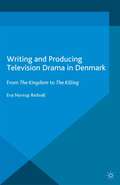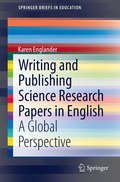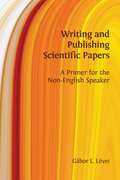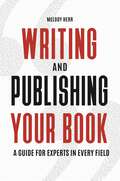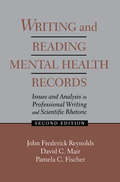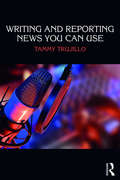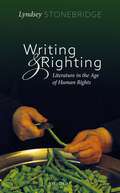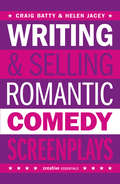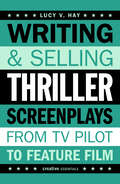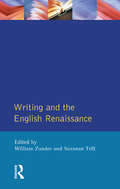- Table View
- List View
Writing and Producing Television Drama in Denmark: From The Kingdom to The Killing (Palgrave Studies in Screenwriting)
by Eva Novrup RedvallOffering unique insights into the writing and production of television drama series such as The Killing and Borgen, produced by DR, the Danish Broadcasting Corporation, Novrup Redvall explores the creative collaborations in writers' rooms and 'production hotels' through detailed case studies of Denmark's public service production culture.
Writing and Publishing in Architecture and Design
by Anne MasseyThis book outlines the process of writing and publishing research in the field of architecture and design. The book sets out to help researchers find a voice and find the best fit for their work. Information about the different types of publication on offer is set out, as well as how to make that important initial approach. From pitching an idea for a review in a magazine, to producing a journal article right through to the monograph, Writing and Publishing in Architecture and Design maps out the different steps for the novice author. Your first steps in publishing can be daunting, and the book offers material which will inspire confidence, by demystifying the publication process. It also includes valuable nuts and bolts material such as planning and structure, time management, writing styles, editing, production of the final manuscript and picture research. How do you turn your PhD into a book? How do you turn conference proceedings into a publication? Commissioning editors and authors share their experiences through interview and offer recipes for success as well as what to avoid. Key titles from the past are included as case studies, and their pathway to publication explored. This is an invaluable book for anyone working in the fields of architecture and design, with an ambition to publish.
Writing and Publishing in Architecture and Design
by Anne MasseyThis book outlines the process of writing and publishing research in the field of architecture and design. The book sets out to help researchers find a voice and find the best fit for their work. Information about the different types of publication on offer is set out, as well as how to make that important initial approach. From pitching an idea for a review in a magazine, to producing a journal article right through to the monograph, Writing and Publishing in Architecture and Design maps out the different steps for the novice author. Your first steps in publishing can be daunting, and the book offers material which will inspire confidence, by demystifying the publication process. It also includes valuable nuts and bolts material such as planning and structure, time management, writing styles, editing, production of the final manuscript and picture research. How do you turn your PhD into a book? How do you turn conference proceedings into a publication? Commissioning editors and authors share their experiences through interview and offer recipes for success as well as what to avoid. Key titles from the past are included as case studies, and their pathway to publication explored. This is an invaluable book for anyone working in the fields of architecture and design, with an ambition to publish.
Writing and Publishing Science Research Papers in English: A Global Perspective (SpringerBriefs in Education)
by Karen EnglanderThis book provides a comprehensive review of the current knowledge on writing and publishing scientific research papers and the social contexts. It deals with both English and non-Anglophone science writers, and presents a global perspective and an international focus. The book collects and synthesizes research from a range of disciplines, including applied linguistics, the sociology of science, sociolinguistics, bibliometrics, composition studies, and science education. This multidisciplinary approach helps the reader gain a solid understanding of the subject. Divided into three parts, the book considers the context of scientific papers, the text itself, and the people involved. It explains how the typical sections of scientific papers are structured. Standard English scientific writing style is also compared with science papers written in other languages. The book discusses the strengths and challenges faced by people with different degrees of science writing expertise and the role of journal editors and reviewers.
Writing and Publishing Scientific Papers: A Primer for the Non-English Speaker
by Gábor L. LöveiGábor Lövei’s scientific communication course for students and scientists explores the intricacies involved in publishing primary scientific papers, and has been taught in more than twenty countries. Writing and Publishing Scientific Papers is the distillation of Lövei’s lecture notes and experience gathered over two decades; it is the coursebook many have been waiting for. The book’s three main sections correspond with the three main stages of a paper’s journey from idea to print: planning, writing, and publishing. Within the book’s chapters, complex questions such as ‘How to write the introduction?’ or ‘How to submit a manuscript?’ are broken down into smaller, more manageable problems that are then discussed in a straightforward, conversational manner, providing an easy and enjoyable reading experience. Writing and Publishing Scientific Papers stands out from its field by targeting scientists whose first language is not English. While also touching on matters of style and grammar, the book’s main goal is to advise on first principles of communication. This book is an excellent resource for any student or scientist wishing to learn more about the scientific publishing process and scientific communication. It will be especially useful to those coming from outside the English-speaking world and looking for a comprehensive guide for publishing their work in English.
Writing and Publishing Your Book: A Guide for Experts in Every Field
by Melody Herr Ph.D.Are you ready to write your book? Partner with an experienced publisher, writing coach, and author and find out how to turn your research and scholarship into a book.This book is the next-best-thing to a personal writing coach. Drawing upon her own extensive experience as an author and publisher, Melody Herr guides the reader through every step of the writing and publishing process: constructing a table of contents, preparing a proposal, finding a publisher, negotiating a contract, drafting the manuscript, and marketing the finished product. Throughout, she offers proven strategies for producing a book that highlights its author's authoritative knowledge and writing skills. Unique among writing guides, Writing and Publishing Your Book: A Guide for Experts in Every Field acknowledges the reader's own expertise; speaks to researchers and scholars across the sciences, social sciences, and humanities; and provides information and guidance that will benefit junior authors as well as their more senior colleagues. By following these practical, step-by-step instructions, new authors will more easily liberate their own creativity while avoiding the many pitfalls that mire new writers, thereby maintaining momentum for a successful publication.
Writing and Publishing Your Book: A Guide for Experts in Every Field
by Melody Herr Ph.D.Are you ready to write your book? Partner with an experienced publisher, writing coach, and author and find out how to turn your research and scholarship into a book.This book is the next-best-thing to a personal writing coach. Drawing upon her own extensive experience as an author and publisher, Melody Herr guides the reader through every step of the writing and publishing process: constructing a table of contents, preparing a proposal, finding a publisher, negotiating a contract, drafting the manuscript, and marketing the finished product. Throughout, she offers proven strategies for producing a book that highlights its author's authoritative knowledge and writing skills. Unique among writing guides, Writing and Publishing Your Book: A Guide for Experts in Every Field acknowledges the reader's own expertise; speaks to researchers and scholars across the sciences, social sciences, and humanities; and provides information and guidance that will benefit junior authors as well as their more senior colleagues. By following these practical, step-by-step instructions, new authors will more easily liberate their own creativity while avoiding the many pitfalls that mire new writers, thereby maintaining momentum for a successful publication.
Writing and Race (Crosscurrents)
by Tim YoungsWriting and Race brings together specially commissioned essays by new and established authors from a range of disciplines. Texts are drawn from subjects and genres that include philosophy, politics, anthropology, sexuality, travel, fiction and autobiography. Through a time-span from Ancient Greece to the present day, and a geographical coverage from Australia and Europe to the Caribbean and the United States, the collection investigates the importance of place, moment, cultural formation and subject identity in racial representation. A substantial introduction establishes the connections between the essays and lucidly summarizes recent thinking on race, explaining in particular the relevance of debates about ethnography.Accessible and stimulating, Writing and Race is a multidisciplinary collection that will be of interest to students, researchers, and lecturers who study or are interested in race. The essays represent a variety of critical approaches, thus allowing the reader to compare and contrast the benefits of each approach. Extracts of some of the texts that are discussed are included along with an extensive bibliography to encourage further study.
Writing and Race (Crosscurrents)
by Tim YoungsWriting and Race brings together specially commissioned essays by new and established authors from a range of disciplines. Texts are drawn from subjects and genres that include philosophy, politics, anthropology, sexuality, travel, fiction and autobiography. Through a time-span from Ancient Greece to the present day, and a geographical coverage from Australia and Europe to the Caribbean and the United States, the collection investigates the importance of place, moment, cultural formation and subject identity in racial representation. A substantial introduction establishes the connections between the essays and lucidly summarizes recent thinking on race, explaining in particular the relevance of debates about ethnography.Accessible and stimulating, Writing and Race is a multidisciplinary collection that will be of interest to students, researchers, and lecturers who study or are interested in race. The essays represent a variety of critical approaches, thus allowing the reader to compare and contrast the benefits of each approach. Extracts of some of the texts that are discussed are included along with an extensive bibliography to encourage further study.
Writing and Reading Mental Health Records: Issues and Analysis in Professional Writing and Scientific Rhetoric
by J. Frederick Reynolds David C. Mair Pamela C. FischerThis revised and updated second edition is a rhetorical analysis of written communication in the mental health community. As such, it contributes to the growing body of research being done in rhetoric and composition studies on the nature of writing and reading in highly specialized professional discourse communities. Many compelling questions answered in this volume include: * What "ideological biases" are reflected in the language the nurse/rhetorician uses to talk to and talk about the patient? * How does language figure into the process of constructing meaning in this context? * What social interactions -- with the patient, with other nurses, with physicians -- influence the nurse's attempt to construct meaning in this context? * How do the readers of assessment construct their own meanings of the assessment? Based on an ongoing collaboration between composition studies specialists and mental health practitioners, this book presents research of value not only to writing scholars and teachers, but also to professional clinicians, their teachers, and those who read mental health records in order to make critically important decisions. It can also be valuable as a model for other scholars to follow when conducting similar long-range studies of other writing-intensive professions.
Writing and Reading Mental Health Records: Issues and Analysis in Professional Writing and Scientific Rhetoric
by J. Frederick Reynolds David C. Mair Pamela C. FischerThis revised and updated second edition is a rhetorical analysis of written communication in the mental health community. As such, it contributes to the growing body of research being done in rhetoric and composition studies on the nature of writing and reading in highly specialized professional discourse communities. Many compelling questions answered in this volume include: * What "ideological biases" are reflected in the language the nurse/rhetorician uses to talk to and talk about the patient? * How does language figure into the process of constructing meaning in this context? * What social interactions -- with the patient, with other nurses, with physicians -- influence the nurse's attempt to construct meaning in this context? * How do the readers of assessment construct their own meanings of the assessment? Based on an ongoing collaboration between composition studies specialists and mental health practitioners, this book presents research of value not only to writing scholars and teachers, but also to professional clinicians, their teachers, and those who read mental health records in order to make critically important decisions. It can also be valuable as a model for other scholars to follow when conducting similar long-range studies of other writing-intensive professions.
Writing and Religion in England, 1558-1689: Studies in Community-Making and Cultural Memory
by Anthony W. JohnsonThe fruit of intensive collaboration among leading international specialists on the literature, religion and culture of early modern England, this volume examines the relationship between writing and religion in England from 1558, the year of the Elizabethan Settlement, up until the Act of Toleration of 1689. Throughout these studies, religious writing is broadly taken as being 'communicational' in the etymological sense: that is, as a medium which played a significant role in the creation or consolidation of communities. Some texts shaped or reinforced one particular kind of religious identity, whereas others fostered communities which cut across the religious borderlines which prevailed in other areas of social interaction. For a number of the scholars writing here, such communal differences correlate with different ways of drawing on the resources of cultural memory. The denominational spectrum covered ranges from several varieties of Dissent, through via media Anglicanism, to Laudianism and Roman Catholicism, and there are also glances towards heresy and the mid-seventeenth century's new atheism. With respect to the range of different genres examined, the volume spans the gamut from poetry, fictional prose, drama, court masque, sermons, devotional works, theological treatises, confessions of faith, church constitutions, tracts, and letters, to history-writing and translation. Arranged in roughly chronological order, Writing and Religion in England, 1558-1689 presents chapters which explore religious writing within the wider contexts of culture, ideas, attitudes, and law, as well as studies which concentrate more on the texts and readerships of particular writers. Several contributors embrace an inter-arts orientation, relating writing to liturgical ceremony, painting, music and architecture, while others opt for a stronger sociological slant, explicitly emphasizing the role of women writers and of writers from different sub-cultural backgrounds.
Writing and Religion in England, 1558-1689: Studies in Community-Making and Cultural Memory
by Anthony W. JohnsonThe fruit of intensive collaboration among leading international specialists on the literature, religion and culture of early modern England, this volume examines the relationship between writing and religion in England from 1558, the year of the Elizabethan Settlement, up until the Act of Toleration of 1689. Throughout these studies, religious writing is broadly taken as being 'communicational' in the etymological sense: that is, as a medium which played a significant role in the creation or consolidation of communities. Some texts shaped or reinforced one particular kind of religious identity, whereas others fostered communities which cut across the religious borderlines which prevailed in other areas of social interaction. For a number of the scholars writing here, such communal differences correlate with different ways of drawing on the resources of cultural memory. The denominational spectrum covered ranges from several varieties of Dissent, through via media Anglicanism, to Laudianism and Roman Catholicism, and there are also glances towards heresy and the mid-seventeenth century's new atheism. With respect to the range of different genres examined, the volume spans the gamut from poetry, fictional prose, drama, court masque, sermons, devotional works, theological treatises, confessions of faith, church constitutions, tracts, and letters, to history-writing and translation. Arranged in roughly chronological order, Writing and Religion in England, 1558-1689 presents chapters which explore religious writing within the wider contexts of culture, ideas, attitudes, and law, as well as studies which concentrate more on the texts and readerships of particular writers. Several contributors embrace an inter-arts orientation, relating writing to liturgical ceremony, painting, music and architecture, while others opt for a stronger sociological slant, explicitly emphasizing the role of women writers and of writers from different sub-cultural backgrounds.
Writing and Reporting News You Can Use
by Tammy TrujilloWriting and Reporting News You Can Use instructs students on how to produce news that is informative, interesting, educational, and most importantly, compelling. It addresses roadblocks to student interest in writing news, using illustrative examples and exercises to help them understand how to write news that is interesting and accurate. Trujillo’s hands-on approach is based on real-world strategies that deal with audience and market characteristics. Students are writing from the very beginning while also getting the ethical and legal grounding necessary to understand the field. This textbook is a complete resource for students learning broadcast news, including how to get a job after leaving the classroom.
Writing and Reporting News You Can Use: News You Can Use
by Tammy TrujilloWriting and Reporting News You Can Use instructs students on how to produce news that is informative, interesting, educational, and most importantly, compelling. It addresses roadblocks to student interest in writing news, using illustrative examples and exercises to help them understand how to write news that is interesting and accurate. Trujillo’s hands-on approach is based on real-world strategies that deal with audience and market characteristics. Students are writing from the very beginning while also getting the ethical and legal grounding necessary to understand the field. This textbook is a complete resource for students learning broadcast news, including how to get a job after leaving the classroom.
Writing and Responsibility
by Carl TigheIn a world where literary scandals often end up in court, the issue of responsibility in writing has never been more important. In this groundbreaking study, Carl Tighe asks the questions every writer needs to consider: *What is it that writers do? Are they responsible for all the uses to which their writing might be put? Or no more responsible than their readers?*How are a writer's responsibilities compromised or defined by commercial or political pressures, or by notions of tradition or originality?*How does a writer's audience affect their responsibilities? Are these the same for writers in all parts of the world, under all political and social systems? The first part of this book defines responsibility and looks at its relation to ideas such as power, accuracy, kitsch and political correctness. The second part examines how particular writers have dealt with these issues through a series of often-controversial case studies, including American Psycho, Crash and The Tin Drum. Writing and Responsibility encourages its readers to interrogate the choices they make as writers. A fascinating look at the public consequences of the private act of writing, Carl Tighe's book is a must-read for everyone who writes or studies writing.
Writing and Responsibility
by Carl TigheIn a world where literary scandals often end up in court, the issue of responsibility in writing has never been more important. In this groundbreaking study, Carl Tighe asks the questions every writer needs to consider: *What is it that writers do? Are they responsible for all the uses to which their writing might be put? Or no more responsible than their readers?*How are a writer's responsibilities compromised or defined by commercial or political pressures, or by notions of tradition or originality?*How does a writer's audience affect their responsibilities? Are these the same for writers in all parts of the world, under all political and social systems? The first part of this book defines responsibility and looks at its relation to ideas such as power, accuracy, kitsch and political correctness. The second part examines how particular writers have dealt with these issues through a series of often-controversial case studies, including American Psycho, Crash and The Tin Drum. Writing and Responsibility encourages its readers to interrogate the choices they make as writers. A fascinating look at the public consequences of the private act of writing, Carl Tighe's book is a must-read for everyone who writes or studies writing.
Writing and Righting: Literature in the Age of Human Rights
by Lyndsey StonebridgeA bold and accessible argument for the moral and political value of literature in rightless times. The obvious humanity of books would seem to make literature and human rights natural allies. But what is the real connection between literature and human rights? In this short polemical book, Lyndsey Stonebridge shows how the history of human rights owes much to the creative imagining of writers. Yet, she argues, it is not enough to claim that literature is the empathetic wing of the human rights movement. At a time when human rights are so blatantly under attack, the writers we need how are the political truthtellers, the bold callers out of easy sympathy and comfortable platitudes.
Writing and Righting: Literature in the Age of Human Rights
by Lyndsey StonebridgeA bold and accessible argument for the moral and political value of literature in rightless times. The obvious humanity of books would seem to make literature and human rights natural allies. But what is the real connection between literature and human rights? In this short polemical book, Lyndsey Stonebridge shows how the history of human rights owes much to the creative imagining of writers. Yet, she argues, it is not enough to claim that literature is the empathetic wing of the human rights movement. At a time when human rights are so blatantly under attack, the writers we need how are the political truthtellers, the bold callers out of easy sympathy and comfortable platitudes.
Writing and Selling Romantic Comedy Screenplays: A Screenwriter's Guide to the RomCom Genre (Writing And Selling Screenplays Ser.)
by Helen JaceyWhat happens when ‘happy ever after’ isn’t quite so simple?Today’s attitudes to love and romance are as varied and diverse as individuals, and audiences want and need more sophisticated, authentic films that show how we live and love now. So what does this mean for the screenwriter developing a romcom? And how do they write heart-warming stories for a genre that is constantly evolving, from bromcom to zomcom to famcom?Writing and Selling Romantic Comedy Screenplays offers a fresh approach to creating narratives for this ever-changing genre. Moving away from rigid and limited definitions that have evolved out of mainstream genre films, the book embraces a working definition that crosses cultural and national boundaries to give screenwriters around the world a truly international perspective on writing comedic love stories.It is the first screenwriting guide to reflect the diversity of approaches in today’s films that deal with the human need for emotional and physical intimacy using humour – the contemporary romantic comedy.'Immensely helpful' - Divya Johry 'An excellent addition to the Creative Essentials screenwriting book family' - WritesSoFluidFeatures of the book include:Illuminating, challenging and provocative about the state of the rom-com genre. Why do some films feel so dated, while others are perennially relevant?Explores and defines all subgenres of romcom, such as zomcom, bromedy, soromcom and famcom.Uniquely draws on creativity, screenwriting genre theory and film industry practice. Stimulating creative exercises at the end of every chapter, and 'hot tips' throughout.Adaptable concepts that can be applied to both feature films and short films.Encourages screenwriters to define their own values about love to ensure their voice and message is original - and commercial.Case studies and analyses of produced screenplays, including Dostana, Due Date, I Give it a Year, I love You, Man, Midnight in Paris, Ruby Sparks, Tamara Drewe, Ted and Warm BodiesInterviews with writers, directors and producers.Genuine international perspectiveIndispensible guide for both the student and the professional writer or filmmaker.
Writing and Selling Thriller Screenplays: A Screenwriter's Guide for Film and Television (Writing And Selling Screenplays Ser.)
by Lucy V. HayWriting and Selling Thriller Screenplays has the lowdown not only on getting your thriller feature script on the page, but getting it in front of producers and investors.From premise to resolution, Lucy V. Hay guides you through the craft of thriller writing, citing classic thrillers such as Psycho, The Shining, The Sixth Sense and Fatal Attraction and lesser-known gems like Red Eye, Desperate Measures, Impostor and Deviation.The book also considers how the screenplay might be sold to investors, looking at high concept ideas, pitching, packaging and the realities of film finance.Lucy V. Hay asks: what is flight vs. fight? What is the difference between horror and thriller? What are the different sub genres of thriller? What part do actors play in film finance? How can limited locations create new opportunities in storytelling and financing? Why is the lone protagonist so in demand? Why are female characters so popular in thriller? And much, much more...'Really hones in on the specific genre of thrillers with expertise' - Write So Fluid'A must-read for any writer, producer or director looking to create (or in the process of creating) a thriller production. It could also be immensely useful for those generally curious about the genre or looking to learn more' - Film Doctor'This book should form part of the armoury for any screenplay writers bookshelf' - Stephen HallCheck out Lucy V. Hay's other screenwriting books: Writing & Selling Drama Screenplays and Writing Diverse Characters for Fiction, Film and TV
Writing and Society: Literacy, Print and Politics in Britain 1590-1660
by Nigel WhealeWriting and Society is a stunning exploration of the relationship between the growth in popular literacy and the development of new readerships and the authors addressing them. It is the first single volume to provide a year-by-year chronology of political events in relation to cultural production.This overview of debates in literary critical theory and historiography includes facsimile pages with commentary from the most influential books of the period. The author describes and analyses:* the development of literacy by status, gender and region in Britain* structures of patronage and censorship* the fundamental role of the publishing industry* the relation between elite literary and popular cultures* and the remarkable growth of female literacy and publication.
Writing and Society: Literacy, Print and Politics in Britain 1590-1660
by Nigel WhealeWriting and Society is a stunning exploration of the relationship between the growth in popular literacy and the development of new readerships and the authors addressing them. It is the first single volume to provide a year-by-year chronology of political events in relation to cultural production.This overview of debates in literary critical theory and historiography includes facsimile pages with commentary from the most influential books of the period. The author describes and analyses:* the development of literacy by status, gender and region in Britain* structures of patronage and censorship* the fundamental role of the publishing industry* the relation between elite literary and popular cultures* and the remarkable growth of female literacy and publication.
Writing and the English Renaissance (Crosscurrents)
by William Zunder Suzanne TrillWriting and the English Renaissance is a collection of essays exploring the full creative richness of Renaissance culture during the sixteenth and seventeenth centuries. As well as considering major literary figures such as Spenser, Marlowe, Donne and Milton, lesser known - especially women - writers are also examined. Radical writing and popular culture are considered as well. The scope of the study not only extends the parameters for debate in Renaissance studies, but also adopts a radical interdisciplinary approach, bridging the gap between literary, historical, cultural and women's studies, leading to a much fuller picture of life in the sixteenth and seventeenth centuries.The authors discussed are placed in their full historical and literary context, with an extensive selection of original documentation included in the text - for example, from The Book of Common Prayer or the Homilies to contextualize the writing under discussion. This distinctive approach, combined with a detailed chronology of the period and bibliography, embracing both canonical and non-canonical writers, makes this volume a unique reference resource and course reader for Renaissance studies.
Writing and the English Renaissance (Crosscurrents)
by William Zunder Suzanne TrillWriting and the English Renaissance is a collection of essays exploring the full creative richness of Renaissance culture during the sixteenth and seventeenth centuries. As well as considering major literary figures such as Spenser, Marlowe, Donne and Milton, lesser known - especially women - writers are also examined. Radical writing and popular culture are considered as well. The scope of the study not only extends the parameters for debate in Renaissance studies, but also adopts a radical interdisciplinary approach, bridging the gap between literary, historical, cultural and women's studies, leading to a much fuller picture of life in the sixteenth and seventeenth centuries.The authors discussed are placed in their full historical and literary context, with an extensive selection of original documentation included in the text - for example, from The Book of Common Prayer or the Homilies to contextualize the writing under discussion. This distinctive approach, combined with a detailed chronology of the period and bibliography, embracing both canonical and non-canonical writers, makes this volume a unique reference resource and course reader for Renaissance studies.
